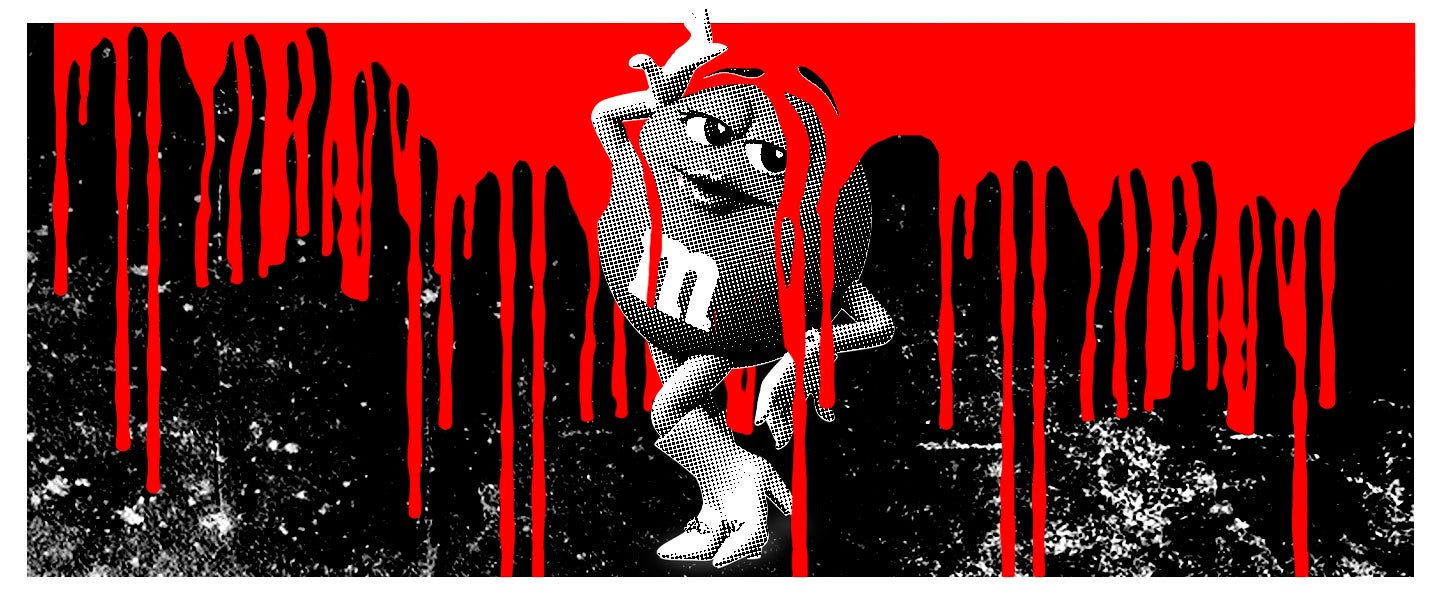Green and Brown, the anthropomorphic M&M’s, are canoodling on a sandy beach as turquoise waves crash behind them. Brown’s legs cross at the knee; Green’s intersect at the ankle. Their signature footwear is kept impressively clean: go-go boots for Green and pumps for Brown. Green’s left hand is sandwiched between Brown’s two palms, the stack resting on Brown’s right knee. The whole scene is erotic enough, but I can’t stop looking at their eyes — they’re just daring you to say something.
Maybe they’re thinking: Ugh, the paparazzi is out here again trying to out us to our family-friendly audience, but we can’t be bothered — and our pearly-white shoes can’t get sandy.
The M&M’s ad copy put it more subtly, however: “It’s rare Ms. Brown and I get to spend time together without some colorful characters bargaining in. — Ms. Green.”
It’s rare Ms. Brown and I get to spend time together without some colorful characters barging in. – Ms. Green pic.twitter.com/hnoktsAgAW
— M&M'S (@mmschocolate) June 28, 2015
Note that M&M’s never actually stated the two were queer — it’s only suggested. (Speaking to MEL, a representative for the brand declined to comment on that tweet or confirm that the two candies are canonically gay.) But the 2015 tweet’s timing was savvy: It landed two days after the landmark Supreme Court ruling that legalized gay marriage nationwide, and it marked the first time — aside from “Taste the Rainbow” — a candy had ever been implied to be sorta, kinda, probably queer.
Interest picked up in 2016. Catherine Hauxwell, a trans woman from Michigan, was scrolling through Google images of the Green M&M and stumbled upon an older, egg-shaped Green, appearing without those long, fluttery lashes, signature go-go boots or matching gloves. Green looked like a basic, doofy dude, far from the sultry femme fatale she is today.
Hauxwell tweeted the photo, captioning it, “green M&M trans??? really proud of her. she’s come a LONG way.”
green M&M trans???
really proud of her. she's come a LONG way pic.twitter.com/4ssh8YX7ER— Catheterine (@funfettiKitty) October 23, 2016
“she’s my transition goal tbh,” Hauxwell added.
“she lost her nut along the way,” someone replied.
The queer canonization of the M&M’s continued with Brown. A photo often shared around Twitter shows a vintage, male-passing Brown M&M as pre–hormone replacement therapy (HRT) and the modern-day Ms. Brown as post-HRT.
gm this a reminder that the brown m&m is a trans lesbian dating the green m&m pic.twitter.com/kMeMXi3T6F
— fbg sheikh (@nasfk_) July 26, 2018
Every few months, the tweets make their rounds once more in queer online communities. Scrolling through their comments and replies reveals that new fans are still learning to love the queer chocolate icons.
“I don’t know how to word it, but I saw [the M&M’s] and immediately thought, ‘Ah, they’re so cute together. Cute girlfriends,’” says nonbinary college student Lisa Castro. “I didn’t feel that… heteronormative feeling that [M&M’s] usually push onto their mascots.”
“I just think it’s funny that in the process of sexualizing the M&M’s, they also made them trans,” says Lee MacLean, a queer 21-year-old student studying psychology. “They’re hot!”
homophobes: gays are taking over!!! the lgbtlmnop are ruining our children!!! why do they want everything to be about them!!!
us: the brown m&m and the green m&m are trans lesbians and here’s the proof
— limp dick disease (@fuckxlee) July 28, 2018
the green m&m lady is a trans lesbian pic.twitter.com/ADNg4vjUJo
— stay mad (@yrfavetrans) September 8, 2019
Getting Green to Shine
Maybe there’s no official statement about the mascots’ queerness, but the mystery only adds to their legend. The image of the queer M&M’s is a surprise rainbow of joy that returns every time a new crop of baby queers come along to discover their chocolate history. How very dramatic (and gay).
But the story begins in 1995, when Mars hired Susan Credle and Steve Rutter of the mega marketing agency BBDO to revamp the M&M’s campaign. The ad team set out to create new personalities for each color: red, green, yellow and brown, as well as orange (pretzel) and tan (peanut). In the mid-’90s, Green was a simple repertory player, an egg-shaped man of mystery, as seen here in this 1990 ad:
“We didn’t want to write for these kind of characters,” Credle tells MEL. So Credle and Rutter revamped them as CGI candies with complex personalities, flaws and grit.
“We knew the characters and advertising candy to children was going to be a problem in the future,” Credle tells MEL. “We need to have adult things in here so that we can prove we’re using the characters in a much more mature way than for children.” Sure enough, six major candy companies in 2016 pledged to stop advertising to children, including Peeps, Jelly Belly and Mike and Ike.
BBDO looked to sitcoms for these character models. Yellow (the peanut M&M) is a lovable idiot, inspired by Danny DeVito in Taxi. Red is the blustery know-it-all, inspired by George on Seinfeld. Blue, which had just won a promotion to replace Tan, had to be a cool, popular observer, inspired by Bugs Bunny. And rounding out the initial crew was Green. Credle and Rutter needed a female character, and they wanted the energy of Candace Bergen in Murphy Brown and Dixie Carter in Designing Women.
“There is an urban legend that green M&M’s make you horny,” says Credle, now global chief creative officer at leading ad agency FCB Global. So the team decided, “All right, she’s going to be the femme fatale. She’s going to be sexy and the object of desire,” she says.
They snagged A Different World actress Cree Summer to be Green’s raspy voice and launched their new vixen through a series of TV ad campaigns. In 2016, Credle told Business Insider they gave Green go-go boots because they couldn’t figure out how to draw ankles.
Green knows how to work her sexuality. She could be a pin-up, but she’s also the smoke show at the bar. She’s the chocolate Jessica Rabbit. “I respect her power,” says Hauxwell, whose tweet about Green being trans went viral. “She’s sassy and cute … maybe a bit weirdly horny.”
The green m&m should be a trans icon because she got her nuts removed and is a girl now. (Medical transition is not necessary for girlhood to be valid nuts are just mentioned because it is a cool coincidence.) pic.twitter.com/WV9V7KhGzS
— Edge Empress Not Hegel (@EdgeEmpress) December 7, 2018
Bring In Brown
It’d be another 17 years before M&M’s would launch a second female character: Brown, courtesy of Vanessa Williams’ voice. Credle and Rutter didn’t initially write a gender for the character, but they wanted a snobby, intellectual woman like Lilith Sternin from Cheers.
M&M’s brand director Allison Miazga-Bedrick says Brown is different from Ms. Green because of her dry sense of humor, high intelligence and impatience. She’s also a little judgmental.
Credle left BBDO before Brown and Orange appears. “They kind of got it right,” she says of the Brown character. “She’s a little too much like Green. I don’t think they pushed the characters far enough apart.”
Same tho pic.twitter.com/knqSUX4CbI
— Em (@mareadamica) September 9, 2019
Corporatizing Queer Candy
If the M&M’s are coded as queer, why can’t they actually be so? And does it matter?
Mars declined to clarify, but Miazga-Bedrick offered a corporate statement of support for the queer community: “Diversity and inclusion are key values for Mars Wrigley Confectionery, the makers of M&M’s, and supporting the LGBTQIA+ community reflects our ongoing commitment to those values.”
To fans of these sweet queer icons, the backstory has little impact on their interpretation of the characters. “I just hope the Green and Brown M&M’s are living their best lives together,” says Nas Farrakhan, a 23-year-old pansexual paralegal and graphic illustrator.
“Look at their chemistry. I’m kind of jealous lmao,” 20-year-old YouTuber “Not Even Emily” tells MEL. “The point is, they are iconic, and I hope they move in together soon and get a cat.”
As for Credle, she’s honored that characters her team created 25 years ago are still resonating. “If the community wants to rewrite the backstory and put it out there, I think that’s where creativity is born today,” she says.
And it’s not like BBDO didn’t imagine the candies’ romantic life. “We used to say, ‘Do they have sex?’” Credle confesses. “I don’t know — they don’t have ways to really do anything. But we have made them naked before.”

